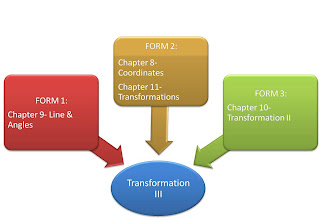FORM 5
CHAPTER 3: TRANSFORMATION III

FIGURE 1: RELATIONSHIPS AND CONNECTIONS TO OTHERS TOPICS

FIGURE 2: SUMMARY OF TOPIC TRANSFORMATIONS III
.1.0 ANALYSIS OF THE TRANSFORMATION SCOPE
Transformations are used to form patterns of shapes which produce beautiful designs. Such designs are used in making batik and attractive fabric prints. We also come across transformation in the movement of object in our daily experiences.
After we had discuss generally about mathematics syllabus, our mainly focus is on the elements of relationship. As we stated above, element of relationship divided into 15 scopes. So, we are interested to discuss about the scope of transformation III.
Transformation introduced to the secondary school for Form 2 students. At this level, transformations scope is focusing on:
1. Understand the concept of transformation
2. Understand and use the concept of translations
3. Understand and use the concept of reflections.
4. Understand and use the concept of rotation.
5. Understand and use the concept of isometry.
6. Understand and use the concept of congruence.
7. Understand and use the properties of quadrilaterals using the concept of transformation.
Then transformation is continued as transformation II for Form 3 students. In Form 2, they able to identify the object and its image in a given transformation. Students also learned to identify a transformation as one-to-one correspondence between points in a plane. So that, students can be easily understand a concept of mapping in an attractive and systematic ways. They had learned how to draw by using tracing paper, or paper folding to get the image of an object under a reflection. Transformation, translation, reflection, rotation, isometry, congruence and properties of quadrilaterals are the concept which we will discuss in this chapter. Transformation II enables students to understand and use the concept to solve a problem.
Transformation III is continued in Form 5, student will be taught to understand and use the concept of combination of two transformation. Therefore, student will be able to determine the image of an objects under combination of two isometric transformations/ two enlargements/ and enlargement and an isometric transformation. The student also able to draw the image of under combination of two transformations. Besides, student will be able to state the coordinate of the image of a point under combined transformation and solve the problems involving transformation.
Transformation III actually relate to the topic Lines & Angels in Form 1. Generally to learn this subtopic, students should be able to understand clearly about topic Lines & Angels. For example, transformation for triangular that represent rotation through 180 at one point. Students must master the Lines & Angels topic first, before solve that kind of question perfectly.
Besides, we also found that the Coordinates’s topic in Form 2 also related to transformation. It is because all subtopic in coordinates such as coordinates, scale for the coordinate axis, distance between two points in a Cartesian plane and midpoint of coordinate that use in transformation learning process.
This scope becomes more details than what they had learned in Form 2 and 3. In Form 5, the learning objective of this topic is to understand and use the concept of combination of two transformations. At the end, students will be able to determine the image of an object under combination of two isometric transformations such as two enlargements and one enlargement with an isometric transformation. Students also can draw the image and state the coordinate’s image of the point under transformations. Then, they used their previous knowledge to solve problem involving transformations.
2.0 PSYCHOLOGIST THEORY RELATED TO THE TEACHING AND LEARNING OF MATHEMATICS
Jerome Bruner
Base on connectivity theorem, every mathematical concepts, principles and skills are connected to other concepts, principles, or skills. For example the transformation related to the topic of line and angel, and coordinates. So the teacher should show the continuity that exists between the mathematics structures.
Robert Gagne
According to Robert Gagne, the mathematics teacher needs to identify important facts related to topics, skills that show emphasized as well as how effective delivery of the concepts and students mastery of the principle to be learned can be achieved. For example, the student is able to identify a translation is said to have mastered the facts. If the student is able to solve translation of objects to get its image then he or she is said to have mastered the skills. If the student is able to determine the form ( whereby ‘a’ is the movements parallel to the x- axis ( positive means a movement to the right and negative means movement to the left) and ‘b’ is the movements parallel to the y- axis ( positive means a movement upward and negative means movement downwards). Finally he or she manage to solve the problem involve translation and then explain it to other students, he or she is said to have mastered the principle.
Mastery Learning
Mastery Learning is an instructional method that presumes all children can learn if they are provided with the appropriate learning conditions. Specifically, mastery learning is a method whereby students are not advanced to a subsequent learning objective until they demonstrate proficiency with the current one. Mastery Learning includes many elements of successful tutoring and the independent functionality seen in high – end students. In a mastery learning environment, the teacher directs a variety of group- based instructional techniques, with frequent and specific feedback by using diagnostic, formative tests, as well as regularly correcting mistakes students make along their learning path. Mastery learning related to this subtopic in determine the image of an objects under combination of two isometric transformations, the student must understand and mastery some skills of the transformations such as translation, rotation, reflection, and enlargement.



